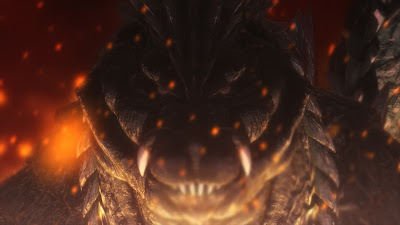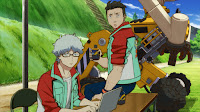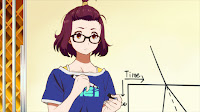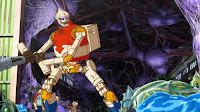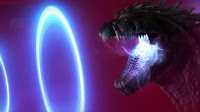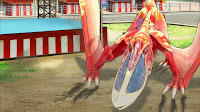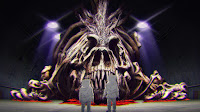Godzilla Singular Point is available in streaming form on Netflix
It all begins as a mysterious song plays from an abandoned mansion. As engineers Yun Arikawa and Haberu Katō attempt to trace it back to its source, elsewhere genius researcher Mei Kamino has also been brought in to investigate. A catastrophe is approaching, heralded by the arrival of a mysterious red dust and a swarm of bizarre monsters. Monsters that by all science and logic maybe shouldn't exist.
As Mei Kamino travels the world in an attempt to stop the catastrophe and understand the "Singular Point", Yun - along with the team at the Otaki Factory and their robot Jet Jaguar, take on these monstrous creatures directly. But these are nothing compared to what's coming, as Godzilla approaches...
Godzilla as a franchise has been a lot of things over the years. Whilst its origins are firmly rooted in being an allegory for the horrors of nuclear warfare, since then it has expanded into everything from colourful movies about alien invasions to a political commentary on the ineptness of bureaucracy. Godzilla himself has been both a destructive force of nature, and Japan's greatest protector. Change and evolution is as vital to the franchise as Godzilla himself, and while it will always eventually return to its nuclear beginnings it's clear that Toho aren't afraid to experiment with what Godzilla can be. And "experiment" couldn't be a more appropriate word to describe Godzilla Singular Point, developing both its story and monsters around the a very heavy dose of theoretical science and mathematics. From the convoluted mechanics at play here to the lengthy explanations required each episode to make everything flow coherently, Godzilla Singular Point almost immediately walks a fine line between engaging its audience and alienating them entirely. A university degree or two might be needed to confirm whether or not the science is legitimate or not, but at the very least the show is able to do a good job of convincing you that it is. While I'm not familiar with the works of Toho Enjou it's clear that he's in his element here. Even though Netflix have dropped the entire season at once to satisfy that "binge watch" model they usually strive for, it's not really a series suited to being done all in one go. Each episode continues to expand on the already complicated science of the previous one, so a period of reflection after each one just to take it all in almost feels mandatory.
The main reason Singular Point manages to comfortably skirt around this though is the simple fact that the characters are great. Whilst the monsters might be draw for any Godzilla production, its the humans that carry the story - and if they aren't done well, it doesn't take very much for the whole thing to fall flat. Admittedly there isn't a whole lot of depth to any of the characters in the series - we get next to nothing in the way of backstory as the plot is largely concerned in the "now" of the whole situation. This isn't a bad thing though as it gives the show a greater sense of urgency, and how memorable the characters are relies far more on personality. Godzilla Singular Point is a story that's told across two fronts - Mei and Yun may not directly interact face to face, but remain constantly in contact as they try to make sense of all the strange things happening around them. They're excellent compliments to each other, and their various instant message exchanges not only help them piece together the science of it all but also break it down in a way that's somewhat understandable to the viewer. Both are surrounded by supporting characters in their pursuit for knowledge, but for Mei it feels a lot more like a solo mission - her only consistent companion throughout the whole thing being the plucky artificial intelligence Pelops II. In comparison Yun feels far more surrounded by people, though not all of them necessarily leave as much of an impact. For example, Haberu often feels like he's only there for Yun to have someone to explain all the science going on to. Gorō Otaki, owner of Otaki Factory and the creator of Jet Jaguar, however is brilliant. A wizened, somewhat eccentric inventor, Gorō is a hot-blooded man of action - a fighter who sees things as they are and has devoted himself to "protecting the Earth". Even though he's another brilliant mind in a cast of geniuses, his dialogue is far less stunted in lengthy explanations which immediately makes him more relatable and more of a standout. The show also features an extensive supporting cast, all of whom are naturally also caught up in this global catastrophe - most looking to prevent it, though clearly not all doing it completely above board. Its characterisation of AI characters, one of whom is personified as a colourful cartoon dog, is superbly done - making the audience care just as much about them (if not more so) than the human characters themselves.
As great as these characters are though, at the end of day it's still a Godzilla series and so there's a reasonable expectation when it comes to giant monster action. The menagerie of Toho kaiju has been well and truly raided to bring fans an interesting mix of familiar faces, all reimagined with a suitable Singular Point twist. Characteristics of some monsters have even been repurposed into other ones, further extending the number of homages even if they don't get a proper namecheck. Highlights include Rodan becoming a swarm of radiation-emitting monsters that effectively act as the "first warning" of the oncoming threat, and Anguirus gaining precognitive abilities through the vibrations of its spikes. All of these monsters pose a threat to the world, but even they pale in comparison to Godzilla himself. The arrival of the King of the Monsters is a slow burn but one that's built up with perfect precision. Singular Point takes cues from 2016's Shin Godzilla, gradually revealing him through various evolution states before the titanic "Godzilla Ultima" makes its fiery debut. Godzilla's appearance brings an immediate sense of dread, which is then only amplified by Akira Ikufube's iconic main theme. And on the off chance that you aren't sold by these new interpretations and would still prefer to see the classics, the end credit sequence is filled with the kind of cameos that would make any long-time Godzilla feel misty-eyed.
But even though its Godzilla's name on the title card, there isn't any doubt that Jet Jaguar is the true star of Singular Point. Even though the character has only ever had one prior appearance in the film series (1973's Godzilla vs. Megalon), Godzilla's robotic ally quickly became a firm fan favourite and was long overdue a starring role of this calibre. When we begin Singular Point we see this is a very different Jet Jaguar - a cruder, piloted robot that probably wouldn't look that out of place in the real world. But even in this form Jet Jaguar shows a tenacity like no other character in the show, and the constant upgrades it receives aren't just a way of prepping it for bigger and better fights - they're integral to the story itself. Much like the other kaiju that appear it's a reinterpretation that puts a new spin on the character to play into the show's unique mechanics, but Jet Jaguar is unique in the fact that it makes the character more developed and endearing than ever before. Singular Point's Jet Jaguar is so good that Otaki Factory put them on their jackets, and if that isn't a sign that they're the most valuable player in the whole thing then I don't know what is.
As a collaboration between two different studios, each working on a different element, Godzilla Singular Point has a very interesting visual style. The main takeaway is that the show is extremely colourful, drenching its characters in brightly coloured clothes against brilliantly lit backdrops. Even in its darker moments (both visually and thematically - and usually involving monsters) the world is soaked in the rich red dust that signals the oncoming catastrophe. Bones bring their usual high standard of work to the backdrops and character animation, whilst Orange handle the titanic task of the monsters themselves. While seeing the two very distinct aesthetics blended together can be a little jarring at first, that feeling quickly subsides as the action begins to ramp up. But at the same time, the obvious difference in styles also works from a story perspective as well - these strange monsters immediately looking as though they don't belong in this world.
Although Godzilla Singular Point's need to feel like the cleverest person in the room can sometimes feel like a hindrance, it's a series that nevertheless manages to work because it never loses sight of exactly what it wants to be. It's because of the enjoyable characters that it's able to adequately get its message across (even if you don't fully understand it along the way), and the imaginative reimagining of the classic Toho monsters ensure that it has the level of spectacle any Godzilla production should have. Bones and Orange have proved they have what it takes to make a Godzilla anime series work, and with the show ending on a brilliant hook for season two there still may be plenty more to come in the future.

